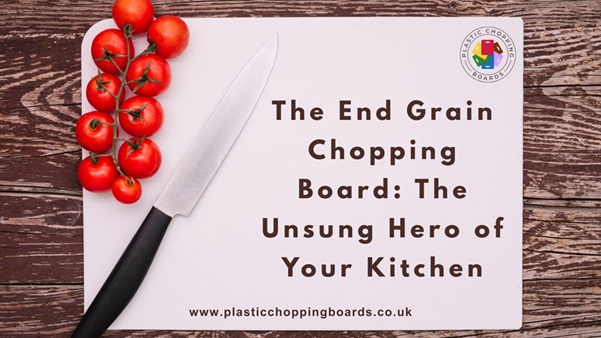
If you’re prepping your meals, the chopping board may not be the most appealing kitchen gadget. But let us tell you, it’s doing more than its share of the heavy work. Whether you are chopping onions, carving a roast dinner, or dicing fruit to put in your morning smoothie, your cutting board is centre stage.
Of all the varieties of cutting boards found in the UK, from plastic cutting boards to heavy-duty commercial chopping boards, there’s one that’s particularly special for its strength, sophistication, and friendliness to knives: the end grain chopping board.
So, what in the world is an end-grain board? And why are chefs and serious cooks throughout the UK obsessing over it? Let’s get into it.
What is an End Grain Chopping Board?
Unlike typical kitchen cutting boards, where the face or edge of the wood is utilised, end grain boards are constructed with small pieces of wood laid end to end so that the wood grain is up.
Just imagine you are staring at the very top of a tree stump, which is the end grain. When a knife is cut down to an end-grain board, it passes between the fibres of the wood instead of chopping through them. The fibres then “heal” themselves, making the board self-repairing to a degree.
This particular construction makes end-grain boards stronger and more durable than their edge- or face-grain counterparts. And yes, your knives will appreciate it.
Why UK Cooks Love End Grain Chopping Boards
Let’s discover what makes end-grain boards a favourite in numerous UK kitchens:
1. Gentle on Knives
In home and professional kitchens, a significant investment is in knives. End-grain boards have a reputation for keeping your blades sharper longer than plastic cutting boards or other types of wooden boards. Making an investment in quality knives is a huge plus.
2. Durability
Thanks to their “self-healing” properties, end-grain boards are virtually indestructible. Given reasonable care, they’ll last decades. That’s one of the reasons they’re a popular choice among people looking to buy chopping boards UK-wide.
3. Stylish & Premium Look
End-grain boards are not only functional, they’re stunning too. Their distinctive checkered look and solid weight give them a professional, premium appearance that complements any kitchen.
4. Safe & Stable
Due to their grip and weight, these boards are less likely to move around when in use, thereby placing them in a safer and more stable position for daily chopping. In contrast to thinner plastic cutting boards that can slip and slide, an end-grain board is more stable and anchored.
The Pros and Cons at a Glance
| Pros | Cons |
| Knife-friendly surface | Heavier than other boards |
| Long-lasting durability | Higher upfront cost |
| Naturally beautiful design | Requires more maintenance |
| Resistant to deep knife scars | Not dishwasher safe |
Comparing End Grain to Other Cutting Board Types
Plastic Cutting Boards
Plastic cutting boards are popular in both domestic and commercial kitchens due to their lightweight design, affordability, and dishwasher-friendliness. They’re liable to be cut very deeply and retain bacteria, though, and tend to dull knife blades fast.
Edge Grain & Face Grain Boards
Edge-grain boards are constructed using the sides of the wood planks. They’re usually cheaper than end-grain boards and are very attractive, but not as long-lasting. Edge-grain boards will eventually wear and tear more as time passes.
Face grain boards, with the broad face of the wood being used, are usually the most fragile and are generally more presentation-friendly than heavy chopping.
Commercial Chopping Boards
In a high-volume environment, such as a restaurant or catering company, commercial chopping boards are the ideal choice. These might incorporate colour-coded plastic cutting boards for food safety compliance (e.g., red for raw meat, green for vegetables). Still, for speciality prep stations or carvings of beef, a heavy-duty end grain board could be utilised for performance and durability.
How to Take Care of an End Grain Chopping Board
To maintain your end-grain kitchen chopping board in good condition, this is what you need to do:
1. Hand Wash Only
Do not put your wooden board in the dishwasher. The wood will lose shape and develop cracks due to the heat and moisture. When wet, use a soft soap and warm water, and dry immediately.
2. Oil Regularly
Once or twice a month (or when the board appears dry), use food-safe mineral oil or beeswax-based board conditioner. This will prevent the cracking effect in the wood and maintain a water-resistant finish.
3. Avoid Soaking
Never leave your cutting boards sitting in water. If they soak in too much moisture, they may swell or split.
4. Use Both Sides
Rotate usage to prevent uneven wear. One side for veggies, the other for meats? Smart move.
Is an End Grain Board Worth the Investment?
The short answer? Yes, if you’re passionate about cooking, quality tools, and long-term value. End grain boards are a more expensive initial investment, but they can last you several cheaper cutting boards, look stunning for years, and protect your valuable knives.
They’re ideal for serious home chefs, perfect for gifting to serious cooks, or for elevating your kitchen’s style with a beautiful, functional showpiece.
If you are chopping, slicing, or dicing a lot and need a board that can match your speed, this is your champion.
When Not to Use an End Grain Board
There will be occasions when a plastic cutting board would be better. For instance:
- Raw meat preparation: Plastic boards are simpler to sanitise and more suitable for meats that require washing or scrubbing.
- Outdoor cooking or BBQs: Lightweight plastic boards can be carried more easily.
- Cleaning needs with the dishwasher: End grain boards need to be hand-washed.
End grain is, thus, amazing, but should simply be in a board arsenal-not your only choice.
Final Thoughts
Most people underestimate the importance of the modest kitchen chopping board. And when it comes to durability, knife care, and beauty, the end grain chopping board is in a league of its own. Whether you’re building a collection for your home or upgrading the tools in a commercial kitchen, this board type deserves a place in your setup.
For those who are buying chopping boards UK-wide, don’t just consider materials and sizes; consider how each board integrates with your lifestyle.
If you require a full complement of plastic cutting boards, commercial chopping boards, and an end-grain premium for fine knife work, this complement can elevate your cooking experience to a new level.
Searching for quality chopping board alternatives in the UK? Browse the complete selection at Plastic Chopping Board—from robust plastic to high-quality end grain boards built to endure.








